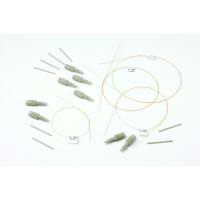Glycoproteins are generally composed of a population of different variants having in common the same polypeptide chain but
varying by their carbohydrate moiety. This carbohydrate-mediated heterogeneity is often called the microheterogeneity of glycoproteins
and the different variants referred to glycoforms. This heterogeneity arises from the presence of different glycannic structures
attached at one glycosylation site. The carbohydrate groups are covalently attached to the polypeptidic backbone through the
amide nitrogen of an asparagin residue (N
-glycosylation) or through an O
-linkage to a serine, a threonine, or sometimes a hydroxyproline residue (O
-glycosylation). N
-linked oligosaccharides may be classified on the basis of the nature of monosaccharides that constitute the oligosaccharides.
High-mannose type oligosaccharides consist of the only mannose and N
-acetylglucosamine residues and are not charged. Complex type oligosaccharides may be negatively charged and contain galactose,
fucose, and sialic acid residues in addition to the monosaccharides found in the high-mannose chains. Hybrid structures are
intermediate structures between the high mannose and the complex type oligosaccharides (see
Appendix, this volume
). The three family of oligosaccharides share the same pentasaccharide structure (GlcNAc-GlcNAc-Man3) by which the oligosaccharide
is attached to the protein. O
-linked oligosaccharides are generally shorter than the N
-oligosaccharides but exhibit larger differences in their monosaccharide composition.






